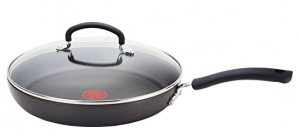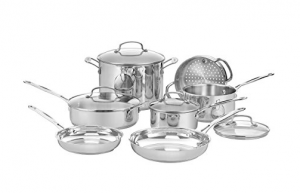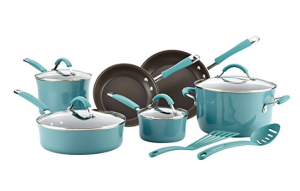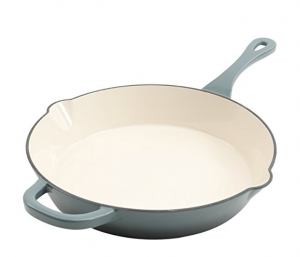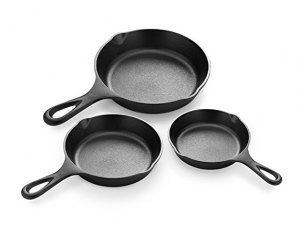While many of us likely make an effort to avoid unnecessary additives and overly processed foods, fewer of us are probably giving thought to the health integrity of the actual cookware we use each day. What makes cookware safe vs. potentially toxic? What steps can we take to improve the quality of our cookware collection if we’re on a tight budget? Let’s take a brief look at the most common types of cookware materials and whether they should be avoided or embraced.
Aluminum
Thanks to its efficient heat-conducting properties and affordable price point, aluminum cookware can be a tempting choice. Aluminum is a controversial metal and a quick Google search will yield findings both in favor of and completely against the use of the material in food preparation, so while I encourage you to do your own research, there have been studies suggesting links between aluminum and Alzheimer’s, kidney disease, and compromised performance of the nervous system. The trace amounts of aluminum that can possibly infiltrate your food—particularly if using this type of cookware to prepare acidic foods (think tomato soup)—is likely more minimal than the presence of the material in common antiperspirant, but again, it’s worth making your own choice on the matter. Aluminum is sometimes used as the core material in pots or pans before being coated in a safer material, but if the coating becomes damaged or wears off with use, you’re back to the initial dilemma of having your food come in direct contact with the metal in question.
Verdict? It’s probably best to avoid aluminum cookware.
Non-Stick / Teflon
It’s hard to argue with a non-stick pan. The easy cleanup is a huge plus, and non-stick cookware is readily available at any price point. So what’s the problem? Depending on the quality of manufacture, a non-sticking coating can be susceptible to flaking off as it wears out with use, or sustains damage from cleaning or the scraping of utensils across the surface. Even in miniscule quantities, you probably don’t want to season your scrambled eggs with bits of the actual frying pan. There are also arguments that toxic fumes can be released if a Teflon-coated pan overheats. Again, I implore you to conduct your own research if you have concerns about the safety of non-stick cookware, and certainly be sure to choose high-quality, well-made pieces when making a purchase.
Verdict? Proceed with caution. Replace your non-stick pan at the first signs of wear or damage, avoid using metal utensils or abrasive cleaning tools, and mind your cooking temperatures.
Stainless Steel
We’ve talked about the safety of stainless steel cookware here before, and the material is generally considered appropriate for use in cooking. The biggest downside of stainless steel is that it is most assuredly not non-stick, so cleaning can be an endeavor. There are also studies suggesting that the material can leach when cooking acidic foods (again, something to think about before cooking up a nice pot of tomato soup) Otherwise, stainless steel pots and pans are affordable, durable, and readily available.
Verdict? Good to go, just keep a neutral cooking oil at the ready to avoid burnt-on disasters.
Ceramic
Ceramic cookware tends to be perfectly safe, so long as a lead-based glaze hasn’t been used to seal it. You’ve probably seen decorative pottery items that look as though they might be useful in the kitchen, but have some sort of label indicating that they aren’t safe for use with food. This should be obvious, but if you’re looking into ceramic cookware options, be sure that the piece is of food-grade production. As ceramic cookware has been around for a long time, perhaps you have a piece that has been handed down through a generation or three. If the pot has gone this long without sending anyone to an early grave, it’s probably fine to continue using; but if you have any suspicions, consider repurposing great-grandma’s ceramic casserole into a decorative piece.
Verdict? Avoid lead and you’re right as rain.
Enameled Cast Iron
While enameled cast iron is synonymous with the likes of Le Creuset, less-costly versions are just as lovely for safe, reliable home cooking. The enameled surface is much lower-maintenance and easier to clean than standard cast iron, and the versatility is unbeatable. I recently wrote about choosing the right size Dutch oven for your needs here, which also offers choices based on price rather than brand alone, and nearly all manufacturers of enameled cast iron cookware produce a full line products from frying pans to baking forms.
Verdict? A+
Cast Iron
Cast iron cookware has been around for a long, long time. It’s incredibly durable and retains heat like nobody’s business, so it’s no wonder the popularity hasn’t waned in the face of new technology. While you do have to season it properly, well-maintained cast iron is easy to work with and tends to be relatively non-stick (without the added chemicals of a Teflon pan). There are no real safety concerns when it comes to cooking with cast iron, in fact, the stronger argument is that these pans actually add iron to our food as we cook, which is beneficial to our health as iron is an essential nutrient.
Verdict? A+
So, how do I upgrade my cookware collection if I can’t afford to do it all at once?
Gradually! Change out one piece at a time, starting with anything you might already have that is damaged or otherwise past its prime. Cast iron and even enameled cast iron pieces can occasionally be found at flea markets or antique stores for a fraction of their cost brand-new, outlet stores can be a great place to score a discount on new cookware, and there’s no shortage of sales portals to watch online.

